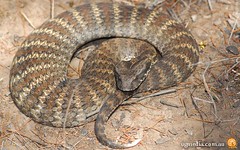 Submitted by Brandon Williams for the Birds & Reptiles class.
Submitted by Brandon Williams for the Birds & Reptiles class.
In a study of the Australian death adder (Acanthophis antarcticus), a member of the Elapidae, Richard Shine observes the convergence of the snake with the Viperidae (Shine 1980). There are no vipers that live in Australia, yet the death adder resembles vipers much more so than other members of the elapids. Shine hypothesizes that the sit-and-wait ambush hunting techniques select for similar adaptations in vipers and death adders. Most elapids are more active searching foragers.
In many ways Shine shows how death adders are adapted in similar ways to vipers rather than their elapid cousins. Death adders feed mostly on ectotherms as juveniles and switch to endotherms as adults. Death adders have a shorter stouter body than most elapids and a pronounced head. A. antarcticus have a delayed sexual maturation and a corresponding slow growth rate. The delayed maturation probably evolved after the ambush hunting strategy, which tends to allow for high survivorship because that leaves less opportunity for predation on the snakes. A. antarcticus has a unique adaptation for ambush hunting which is completely absent in all other elapids, yet is found in nine different vipers. This adaptation is caudal luring; using the thin, yellow wriggling tip of their tail as bait for prey. All of these adaptations point to convergence of the death adder with vipers. The reason for this is the ambush hunting technique.
Shine also posits that because just over half of mature females were found not to be reproductive that female death adders reproduce every other year. He was probably correct, however there could be some genetic or another unseen reason why many of the females were non-reproductive. Testing his hypothesis could be done. He could collect live female specimens of mature size during the breeding season, tag them with a number, noting whether they were reproductive or not, and let them go. Then over the next few breeding seasons he could collect female death adders that had been tagged and note whether the ones that were specifically reproductive last season were non-reproductive the following season. Over a few seasons he could see how consistent the data was with his every other year hypothesis.
Reference:
Shine, R. 1980. Ecology of the Australian Death Adder Acanthophis antarcticus (Elapidae). Pp. 281-289. Evidence for Convergence with the Viperidae. Herpetologists' League.













0 comments:
Post a Comment